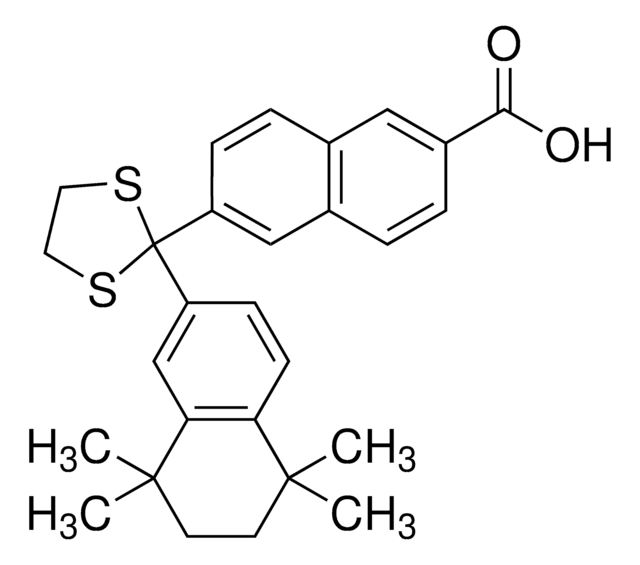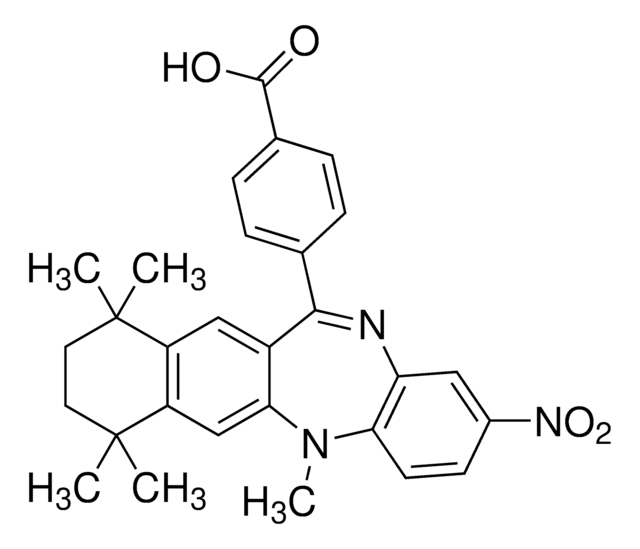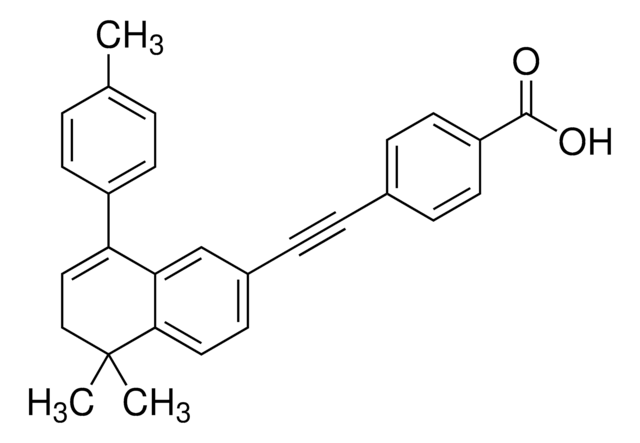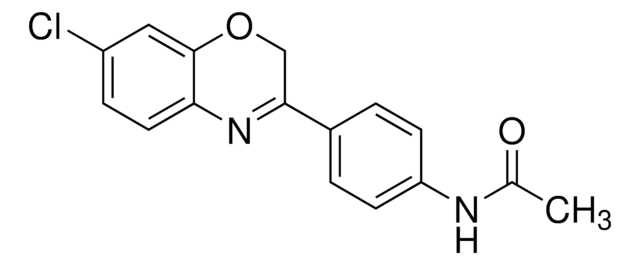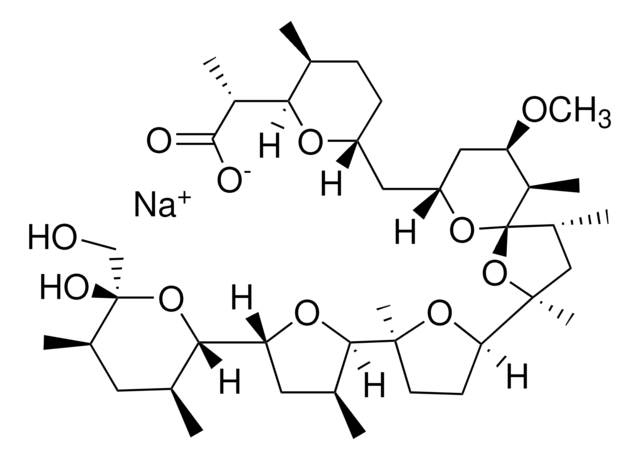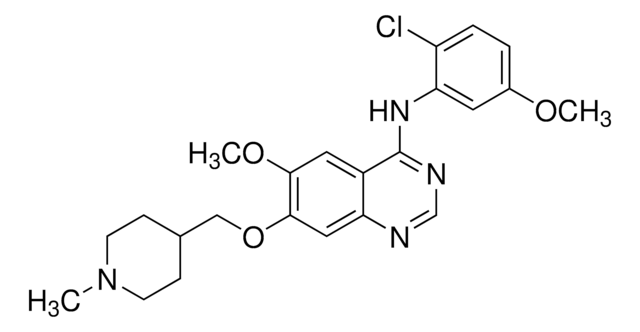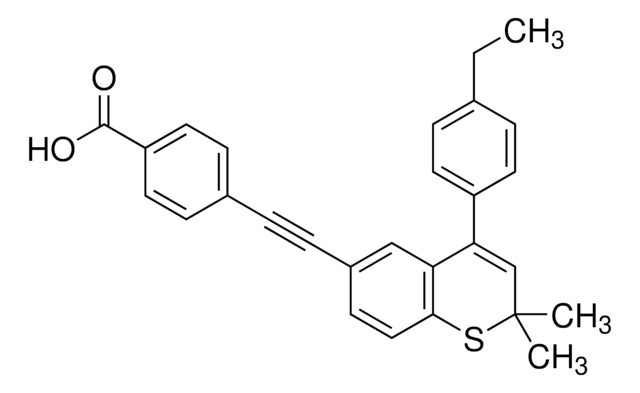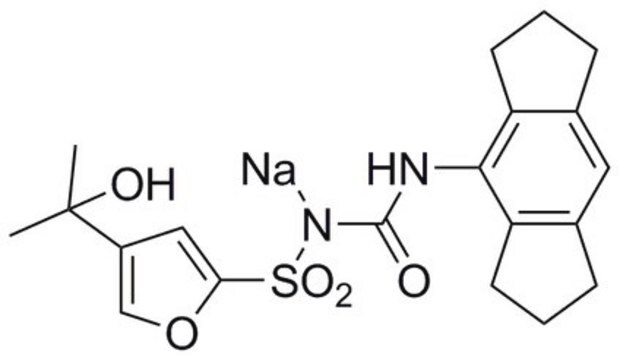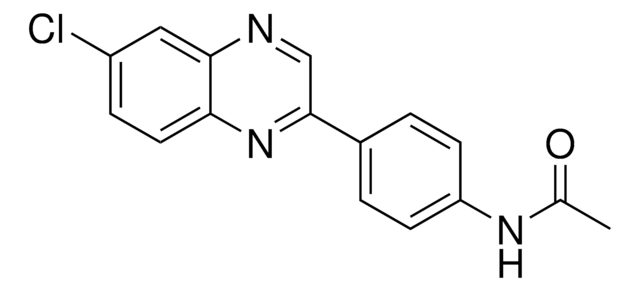推薦產品
品質等級
化驗
≥98% (HPLC)
形狀
powder
顏色
white to beige
溶解度
DMSO: 20 mg/mL, clear
儲存溫度
2-8°C
SMILES 字串
Clc1cc2c(cc1)NC(=CO2)c3ccc(cc3)C
InChI 密鑰
PUXHKTZKBDGXBB-UHFFFAOYSA-N
應用
AR7 has been used:
- as chaperone-mediated autophagy (CMA) activator to study the activity of CMA in rat liver lysosomes
- as a CMA activator to study its effects on expression of DEAD-box helicase 3 X-linked (DDX3X), eukaryotic translation initiation factor 4A1 (EIF4A1), and eukaryotic translation initiation factor 4H (EIF4H) in cancer cells
- to study its effects on synuclein α (SNCA) oligomer levels in mature primary cortical neurons
生化/生理作用
AR7 is an atypical retinoic acid receptor α (RARα) antagonist.
AR7 is an atypical retinoic acid receptor α (RARα) antagonist. There is high interest in retinoic acid receptors for cancer and for differentiation studies. Recently, it has been found that signaling through retinoic acid receptor α (RARα) inhibits chaperone-mediated autophagy (CMA). Disruption of RARα signaling has a stimulatory effect on CMA, but can lead to inhibition of macroautophagy. AR7 antagonizes only the CMA inhibitory effect without affecting macroautophagy, allowing the two RARα effects on autophagy to be studied independently.
訊號詞
Warning
危險聲明
危險分類
Aquatic Acute 1 - Aquatic Chronic 1
儲存類別代碼
11 - Combustible Solids
水污染物質分類(WGK)
WGK 3
閃點(°F)
Not applicable
閃點(°C)
Not applicable
Y R Juste et al.
Methods in molecular biology (Clifton, N.J.), 1880, 703-727 (2019-01-06)
Chaperone-mediated autophagy (CMA) is a selective type of autophagy whereby a specific subset of intracellular proteins is targeted to the lysosome for degradation. These proteins are identified by a chaperone that targets them to lysosomes. There, they are translocated into
Yuqing Hao et al.
Autophagy, 15(9), 1558-1571 (2019-03-02)
Chaperone-mediated autophagy (CMA) is a lysosomal degradation pathway of select soluble proteins. Nearly one-third of the soluble proteins are predicted to be recognized by this pathway, yet only a minor fraction of this proteome has been identified as CMA substrates
Panagiota Mavroeidi et al.
Autophagy, 18(9), 2104-2133 (2022-01-11)
Accumulation of the neuronal protein SNCA/alpha-synuclein and of the oligodendroglial phosphoprotein TPPP/p25A within the glial cytoplasmic inclusions (GCIs) represents the key histophathological hallmark of multiple system atrophy (MSA). Even though the levels/distribution of both oligodendroglial SNCA and TPPP/p25A proteins are
Alba Navarro-Romero et al.
NPJ Parkinson's disease, 8(1), 126-126 (2022-10-07)
Mutations in the GBA gene that encodes the lysosomal enzyme β-glucocerebrosidase (GCase) are a major genetic risk factor for Parkinson's disease (PD). In this study, we generated a set of differentiated and stable human dopaminergic cell lines that express the
Philip Wing-Lok Ho et al.
Autophagy, 16(2), 347-370 (2019-04-16)
Parkinson disease (PD) is an age-related neurodegenerative disorder associated with misfolded SNCA/α-synuclein accumulation in brain. Impaired catabolism of SNCA potentiates formation of its toxic oligomers. LRRK2 (leucine-rich repeat kinase-2) mutations predispose to familial and sporadic PD. Mutant LRRK2 perturbs chaperone-mediated-autophagy
我們的科學家團隊在所有研究領域都有豐富的經驗,包括生命科學、材料科學、化學合成、色譜、分析等.
聯絡技術服務